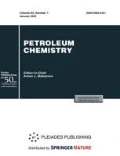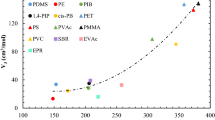Abstract
Gas separation properties of polymer films based on semicrystalline poly(4-methyl-1-pentene) (PMP) with T g = 30°C for permanent gases and some lower hydrocarbons have been experimentally studied in the temperature range of −20 to 80°C. Experiments have been performed using the differential permeability technique involving the determination of the diffusion coefficient by the characteristic time and functional scaling-up methods. It has been shown that PMP as a biphasic system may be characterized by one diffusion coefficient that includes the contributions of diffusion in the amorphous and crystalline phases. It has also been shown that despite the glass transition (phase transition) at 30°C, the permeability coefficients of the test gases exponentially increase with gas temperature and the temperature dependence curves do not exhibit an inflection in the glass transition region. On the other hand, the Arrhenius plots of the diffusion coefficients show a bend over the entire glass transition range in PMP, with the activation energy of diffusion decreasing with an increase in temperature. This fact demonstrates the unusual, earlier unknown effect of increasing activation energy of diffusion E D for gases below T g.
Similar content being viewed by others
References
L. C. Lopez, G. L. Wilkes, P. M. Stricklen, and S. A. White, J. Macromol. Sci., Rev. Macromol. Chem. Phys. 32, 301 (1992).
J. Wang, Z. Xu, and Y. Xu, Chin. J. Polym. Sci. 21, 369 (2003).
R. Abedini, M. Omidkhah, and F. Dorosti, Int. J. Hydrogen Energy 39, 7897 (2014).
G. Zhang, E. Baer, and A. Hilter, Polymer 54, 4298 (2013).
F.-C. Lin, D.-M. Wang, and J.-Y. Lai, J. Membr. Sci. 110, 25 (1996).
US Patent No. 4,421,529 (1983).
US Patent No. 3,798,185 (1974).
A. Wolinska-Grabczyk, A. Jankowski, R. Sekula, and B. Kruczek, Sep. Sci. Technol. 46, 1231 (2011).
Mitsui Chemicals, inc. Performance Polymers Dept. Information and electronics materials div. Japan, 2007. http://www.mitsui-chem.co.jp/service/ pdf/polymer_e.pdf.
H. J. Michaels and H. J. Bixler, J. Polym. Sci. 50, 393 (1961).
V. V. Teplyakov, Doctoral Dissertation in Chemistry (Moscow, 1991).
I. I. Tugov and G. I. Kostrykina, Polymer Physics and Chemistry Textbook (Khimiya, Moscow, 1989).
V. I. Kleiner, S. M. Shishatskii, Yu. P. Yampol’skii, et al., Vysokomol. Soedin., Ser. A 35, 1679 (1993).
R. Hasegara, Y. Tanabe, M. Kobayashi, et al., J. Polym. Sci., Part A-2: Polym. Phys. 8, 1073 (1970).
B. A. Krentsel, Y. V. Kissin, V. J. Kleiner, and L. L. Stotskaya, Polymers and Copolymers of Higher a- Olefins (Hanser/Gardner, Cincinnati, 1997).
J. L. White and D. D. Choi, Polyolefins: Processing, Structure, Development and Properties (Carl Hanser, Munich, 2004).
H. Kusanagi, M. Takase, Y. Chatani, and H. Tadakoro. J. Polym. Sci., Part B: Polym. Phys. 16, 131 (1978).
A. C. Puleo, D. R. Paul, and P. K. Wong, Polymer 30, 1357 (1989).
T. Suzuuki, T. Tanaka, M. Nakajima et al., Polymer, 34, 891 (2002).
Y. Tsujita, Chin. J. Polym. Sci. 1, 301 (2000).
V. V. Zhmakin and V. V. Teplyakov, Membr. Membr. Tekhnol., No. 1, 64 (2016).
I. N. Beckman, The Mathematics of Diffusion: A Student’s Guide (Ontoprint, Moscow, 2016) [in Russian].
V. V. Beckman and V. V. Teplyakov, Adv. Colloid Interface Sci. 222, 70 (2015).
N. M. Nikolaev, Diffusion in Membranes (Khimiya, Moscow, 1980) [in Russian].
V. V. Teplyakov and P. Meares, Gas Sep. Purif. 4, 66 (1990).
O. V. Malykhm A. Yu. Golub, and V. V. Teplyakov, Adv. Colloid Interface Sci. 164, 89 (2011).
J. H. Grifith and B. G. Ranby, J. Polym. Sci. 44, 369 (1960).
Polymer Handbook, Ed. by J. Brandrup and E. H. Immergut (Wiley–Interscience, New York, 1989). 3rd Ed.
P. Meares, J. Polym. Sci., 101 (1956).
P. Meares, J. Polym. Sci., 3415 (1953).
Author information
Authors and Affiliations
Corresponding author
Additional information
Original Russian Text © S.Yu. Markova, N.M. Smirnova, V.V. Teplyakov, 2016, published in Membrany i Membrannye Tekhnologii, 2016, Vol. 6, No. 3, pp. 283–291.
Rights and permissions
About this article
Cite this article
Markova, S.Y., Smirnova, N.M. & Teplyakov, V.V. Gas permeability through poly(4-methyl-1-pentene) at temperatures above and below the glass transition point. Pet. Chem. 56, 948–955 (2016). https://doi.org/10.1134/S0965544116100054
Received:
Published:
Issue Date:
DOI: https://doi.org/10.1134/S0965544116100054



